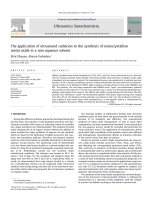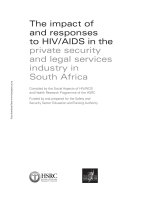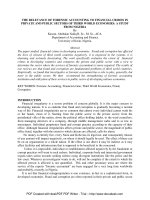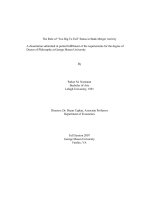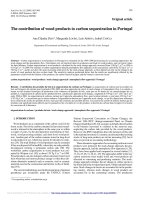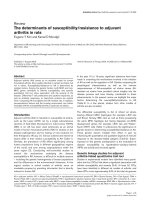the application of glycosphingolipid arrays to autoantibody detection in neuroimmunological disorders
Bạn đang xem bản rút gọn của tài liệu. Xem và tải ngay bản đầy đủ của tài liệu tại đây (8.39 MB, 189 trang )
Glasgow Theses Service
Galban Horcajo, Francesc (2014) The application of glycosphingolipid
arrays to autoantibody detection in neuroimmunological disorders.
PhD thesis.
Copyright and moral rights for this thesis are retained by the author
A copy can be downloaded for personal non-commercial research or
study, without prior permission or charge
This thesis cannot be reproduced or quoted extensively from without first
obtaining permission in writing from the Author
The content must not be changed in any way or sold commercially in any
format or medium without the formal permission of the Author
When referring to this work, full bibliographic details including the
author, title, awarding institution and date of the thesis must be given
The application of
glycosphingolipid arrays to
autoantibody detection in
neuroimmunological disorders
Francesc Galban Horcajo
BSc (Hons) MSc
Thesis submitted for the degree of PhD
to the University of Glasgow,
Institute of Infection, Immunity and Inflammation.
March 2014
2
Author’s Declaration
All experiments and results presented in this thesis are my own work unless
specifically stated otherwise within the text.
Francesc Galban Horcajo, BSc (Hons) MSc
3
Dedication
I dedicate this thesis to my parents, Alfons and Pilar, my sister, Raquel and my
mentor and friend Jesús Batlle.
Whoever you are, I fear you are walking the walks of dreams,
I fear these supposed realities are to melt from under your feet and hands;
Whoever you are, now I place my hand upon you, that you be my poem;
I whisper with my lips close to your ear,
I have loved many women and men, but I love none better than you.
Walt Whitman
4
Table of Contents
Author’s Declaration 2
Dedication 3
Abstract 7
List of Tables 8
List of Figures 9
Definitions/Abbreviations 11
1 Chapter 1. Introduction 13
1.1 Lipids 13
1.1.1 Lipids and cell activity 15
1.1.2 Lipids and cell membrane structure 15
1.1.3 Gangliosides 17
1.2 Domain organization and Membrane Rafts 19
1.3 Lipids and disease 24
1.3.1 Guillain-Barré syndrome (GBS) 25
1.3.2 Multifocal Motor Neuropathy (MMN) 28
1.3.3 Chronic Inflammatory demyelinating polyneuropathy (CIDP) 30
1.4 The application of glycosphingolipid arrays to autoantibody detection in
neuroimmunological disorders 31
1.4.1 Introduction 31
1.4.2 The use of covalent carbohydrate arrays for autoantibody detection
34
1.4.3 The biophysical basis for arrays of heteromeric lipid complexes 35
1.4.4 Conformational modulation of GSLs 36
1.4.5 Cis-interactions between GSLs result in the formation of neoepitopes
or introduce steric hindrance 39
1.4.6 Methodological developments of combinatorial glycoarrays 40
1.5 Summary 42
2 Chapter 2. Materials and Methods 44
2.1 Monoclonal antibody production from existing cell lines 44
2.1.1 Antibody purification 45
2.2 Preparation of liposomes 46
2.3 Quantification of antibody binding to liposomes using flow cytometry . 47
2.4 Affinity Purification using liposomes 48
2.5 Enzyme linked immunosorbant assay (ELISA) 49
2.6 Glycoarray 50
2.6.1 Slide preparation 50
2.6.2 Lipid preparation 50
2.6.3 TLC Printing and program preparation 51
5
2.6.4 Array probing and Analysis 53
2.7 Microarray 55
2.7.1 Microarray generation 55
2.7.2 Microarray probing 55
2.8 Mass spectrometry 56
2.9 Statistical methodologies 57
2.9.1 Normality test 57
2.9.2 Receiver Operator Characteristic (ROC) analysis 57
2.9.3 Heat map analysis 58
2.9.4 Clinical correlation studies 58
3 Chapter 3. Anti-GM1 antibody diversity. 59
3.1 Introduction 59
3.2 Aims 60
3.3 Results 60
3.3.1 Antibody binding to liposomes containing gangliosides 60
3.3.2 Affinity purification of anti-GM1 antibodies from a GBS patient (BTN)
serum 68
3.4 Discussion 74
3.4.1 Future technical improvements 74
3.4.2 Future prospectives 74
3.4.3 Conceptual development 75
4 Chapter 4. Antibodies to heteromeric glycolipid complexes in Multifocal
Motor Neuropathy. 80
4.1 Introduction 80
4.2 Chapter aims 80
4.3 Southern General Hospital serology study 80
4.3.1 Study aims 80
4.3.2 Study design 81
4.3.3 Results 82
4.3.4 Study remarks 97
4.4 Cryptic behaviour of GBS/MMN-derived human monoclonal antibodies. 98
4.4.1 Study aims 98
4.4.2 Results 98
4.5 Dutch MMN validation cohort (first screen) 103
4.5.1 Results 103
4.5.2 Summary 113
4.5.3 Future recommendations 113
4.6 GalC investigations 114
4.6.1 Qualitative differences 114
6
4.6.2 Quantitative differences 118
4.6.3 Future recommendations 122
4.7 Dutch MMN validation cohort (repeat) 123
4.7.1 Study design 123
4.7.2 Results 123
4.7.3 Summary 127
4.7.4 Future recommendations 127
4.8 Discussion 128
5 Chapter 5. Antibodies to heterotrimeric glycolipid complexes in Chronic
Inflammatory Demyelinating Polyrediculoneuropathy. 131
5.1 Introduction 131
5.2 Aims 131
5.2.1 Conceptual aims 131
5.2.2 Experimental aims 131
5.3 Study design 132
5.4 Results 133
5.4.1 Pilot Studies 133
5.4.2 CIDP cohort screening 136
5.5 Future work 146
5.6 Discussion 147
6 Chapter 6. Discussion 149
6.1 Modulation of antibody binding to GM1 149
6.1.1 GM1:GD1a complex inhibition as potential modulator of clinical
phenotypes 152
6.1.2 Molecular ratios of GalC as modulators of antibody binding to GM1
156
6.1.3 Cholesterol as potential modulator of GM1 antibody binding 158
6.1.4 Standardisation of the GM1:GalC assay 159
6.2 Antibodies to heterotrimeric glycolipid complexes in CIDP 162
6.3 Final remarks 163
6.4 In conclusion 165
7 Appendices 166
7.1 Buffers and solutions 166
7.2 Methodological development 167
7.2.1 Fluorescent slides development 167
7.2.2 Fluorescence-ECL comparison 167
7.3 Publications 170
Bibliography 172
7
Abstract
Serum autoantibodies directed towards a wide range of single glycosphingolipids,
especially gangliosides, in humans with autoimmune peripheral neuropathies
have been extensively investigated since the 1980s and these are widely
measured both in clinical practice and research. It has been recently
appreciated that glycosphingolipid and lipid complexes, formed from 2 or more
individual components, can interact to create molecular shapes capable of being
recognised by autoantibodies that do not bind the individual components.
Conversely, 2 glycosphingolipids may interact to form a heteromeric complex
that inhibits binding of an antibody known to bind one of the partners. As a
result of this, previously undiscovered autoantibodies have been identified,
providing substantial new insights into disease pathogenesis and diagnostic
testing. In particular, this newly-termed ‘combinatorial glycomic’ approach has
provided the impetus to redesigning the assay methodologies traditionally used
in the neuropathy-associated autoantibody field. Combinatorial glycoarrays can
be readily constructed in house using any lipids and glycosphingolipids of
interest, and as a result many new antibody specificities to gangliosides and
other glycosphingolipid complexes are being discovered in neuropathy subjects.
Herein we also highlight the role of the neutral lipids cholesterol and
galactocerebroside in modifying glycosphingolipid orientation as two critical
components of the molecular topography of target membranes in nerves that
might favour or inhibit autoantibody binding.
8
List of Tables
Table 1.1. Milestones in lipid research. 14
Table 1.2. Enzymes involved in the biosynthetic pathway of gangliosides 19
Table 2.1. Lipids used in ELISA, Array and liposome experiments. 44
Table 4.1. Sensitivity and specificity values for GM1, GM2, GA1 and
representative complexes. 87
Table 4.2. Top markers. 124
Table 5.1. Comparison of CIDP and Control populations. 140
Table 7.1. Coefficient of variation (CV) for Fluorescence and ECL. 169
9
List of Figures
Figure 1.1. Structure of representative sterols and GSLs. 16
Figure 1.2. Structure and biosynthetic pathway of gangliosides. 18
Figure 1.3. Top view of cell membrane bilayers 22
Figure 1.4. Antibody screening of MFS patient sera. 27
Figure 1.5. MMN Ab binding fingerprint. 30
Figure 1.6 Anti-glycolipid antibody binding to glycolipid complexes analysed by
combinatorial glycoarray and in live tissue. 33
Figure 1.7. Inter- and intra-molecular modulation of GSL conformation. 38
Figure 2.1. Diagram illustrating the formation of GM1-containing multilamelar
vesicles (MLVs). 47
Figure 2.2. Diagramme ilustrating the liposome-based methodology for antibody
affinity purification from patient sera. 49
Figure 2.3. Chromacol vials illustrating the different lipid preparations. 51
Figure 2.4. Example of a programme listing the coordinates for 10 single lipids
and methanol only controls on the first slide. 52
Figure 2.5. Glycoarray slide holder for TLC dispensing 53
Figure 2.6. TotalLab software lay out depicting the measurement of a 9x9 lipid
grid. 54
Figure 2.7. Diagram illustrating the process of printing, probing with the FAST
Frame and scanning the arrays. 56
Figure 3.1. Histogram representing OVA-488 positive liposomes. 62
Figure 3.2. Cholesteryl BODIPY and liposome’s fluorescence intensity. 63
Figure 3.3. Flow Cytometry data corresponding to stained GM1-liposomes. 64
Figure 3.4. Analysis of GM1:GD1a IgG antibodies in the patient JK. 66
Figure 3.5. Histograms depicting DG1 and DG2 binding to liposomes. 67
Figure 3.6. Array illustrating the IgG antibody binding profile of BTN serum. 68
Figure 3.7. Affinity purification process. 70
Figure 3.8. Liposomes spotted using microarray. 71
Figure 3.9. Glycoarray blots depicting GM1:Cholesterol mole to mole
heteromeric complexes and singles lipids. 72
Figure 3.10. Arrays containing GM1 complexes with cholesterol variants probed
with purified IgG GM1:Cholesterol antibody. 73
Figure 3.11. Diagram illustrating the Hypothesis of “GM1 structure change”. 77
Figure 3.12. Two hypothesis for multivalent binding molecules. 79
Figure 4.1. Representative blots from glycoarray. 83
Figure 4.2. Quantitative and statistical analysis of glycoarray data. 86
Figure 4.3. Diagram illustrating Ab binding profiles found in MMN sera 88
Figure 4.4. Patterns of antibody binding in MMN sera. 89
Figure 4.5. Analysis of positive controls. 92
Figure 4.6. Regression analysis of GM1 and/or GM1:GalC for both glycoarray and
ELISA 94
Figure 4.7. Comparative data of ELISA and glycoarray performance for MMN
serum binding to GM1:GalC. 96
Figure 4.8. Glycoarray binding fingerprint of human mAb SM1 . 99
Figure 4.9. Diagrame ilustrating ganglioside molecular mimicry. 100
Figure 4.10. Human monoclonal antibodies binding profile. 102
Figure 4.11. Quantitative analysis of glycoarray data. 104
Figure 4.12. Statistical analysis of best performing biomarkers. 106
Figure 4.13. Heat map representation of Dutch serology data. 108
Figure 4.14. Analysis of negative patients for overall markers. 109
10
Figure 4.15. Representative glycoarray blots. 110
Figure 4.16 Glycoarray and ELISA performance comparison. 111
Figure 4.17. Inter-assay variability of a control sera used during a serology study.
112
Figure 4.18. Phrenosin and Kerasin content of commercial GalC stocks. 116
Figure 4.19. Kerasin and Phrenosin structure. 117
Figure 4.20. Monoclonal antibody binding profile on ELISA. 118
Figure 4.21. The effect of GalC concentration and solubilisation in GM1:GalC
complexes. 120
Figure 4.22. Comparison of different GM1 and GalC concentration. 122
Figure 4.23. Quantitative and statistical analysis of glycoarray data. 125
Figure 4.24. First and second screening correlation studies. 126
Figure 5.1. Array lay out for CIDP cohort screen. 133
Figure 5.2. Ganglioside complexes containing different GalC ratios. 133
Figure 5.3 Patterns of antibody binding in CIDP sera. 135
Figure 5.4. Galnglioside complexes with different adjuvant molecules. 136
Figure 5.5. Data from the CIDP population presented as a clustered Heat map.
137
Figure 5.6. Data from the control population presented as a clustered Heat map.
138
Figure 5.7. Representative blots from glycoarray. 139
Figure 5.8. Statistical analysis of glycoarray data for top markers. 141
Figure 5.9. Characteristic blots depicting enhanced or complex specific
GM3:Sulph:Phre reactivities. 143
Figure 5.10. Heat map depicting the top markers. 144
Figure 5.11. Statistical analysis of glycoarray data for overall markers. 145
Figure 5.12. Ab binding fingerprint after the inclusion of Phre. 146
Figure 7.1. Arrays showing the differential auto fluorescent profile of two
commercial 3M glues. 167
Figure 7.2. Experimental outline of combinatorial arrays using
Chemoluminescence or Fluorescence as detection systems. 168
Figure 7.3. Fluorescence and ECL assay variability. 169
Figure 7.4 Detection methods employed in combinatorial glycoarrays. 170
11
Definitions/Abbreviations
AI – arbitrary intensity
AIDP – acute inflammatory demyelinating polyradiculopathy
BSA - bovine serum albumin
BSA bovine serum albumin
Cardio cardiolipin
Cer – ceramide
Cer ceramides
Chol cholesterol
CI – confidence interval
CIDP chronic inflammatory demyelinating polyradiculoneuropathy
CTB – cholera toxin B subunit
CV – coefficient of variation
DGG digalactosyl diglyceride
DMEM - Dublecco’s Modified Eagle’s medium
ECL - enhanced chemiluminescence
ELISA - enzyme linked immunosorbent assay
FBS – foetal bovine serum
GA1 – asialo-ganglioside GM1
Gal - galactose
GalC - glactocerebroside (galactosylceramide)
GalC galactocerebroside
GBS - Guillain-Barré syndrome
GD1a - disialoganglioside GD1a (Cer-Glc-Gal(NeuAc)-GalNAc-Gal-NeuAc)
GD1b – disialoganglioside GD1b (Cer-Glc-Gal(NeuAc-NeuAc)-GalNAc-Gal)
GD3 - disialoganglioside GD3 (Cer-Glc-Gal-NeuAc-NeuAc)
Glc - glucose
GM1 – monosialoganglioside GM1 (Cer-Glc-Gal(NeuAc)-GalNAc-Gal)
GM2 – monosialoganglioside GM2 (Cer-Glc-Gal(NeuAc)-GalNAc)
GM3 - monosialoganglioside GM3 (Cer-Glc-Gal-NeuAc)
GQ1b – tetrasialoganglioside GQ1b (Cer-Glc-Gal(NeuAc-NeuAc)-GalNAc-Gal-NeuAc-
NeuAc)
HC healthy controls
HRP horseradish peroxidise
IgG immunoglobulin
IVIG intravenous immunoglobulin
LOS lipo-oligosaccharide
LPS lipopolysaccharide
MAG myelin associated glycoprotein
MMN multifocal motor neuropathy
12
NeuAc sialic acid, N-acetylneuraminic acid
OND other neurological disease
ONLS overall neuropathy limitation scale
PBS phosphate buffered saline
PC L alphaphosphatidylcholine
PNS peripheral nervous system
PVDF polyvinylidene fluoride
PVDF-Fl low fluorescence polyvinylidene fluoride
rAb recombinant antibody
SEM standard error of the mean
SM sphingomyelin
SS sphingosine
Sulph sulfatide
TLC Thin layer chromatrography
w:w weight:weight
13
1 Chapter 1. Introduction
1.1 Lipids
Lipids were first identified in 1673 by Tachenius Otto who suggested that an acid
compound was hidden in fat since the strength of alkali disappeared when
making soap. Lipids were then defined as fatty acids and their derivatives, and
substances related biosynthetically or functionally to these compounds.
We now know that lipids are crucial elements of the eukaryotic cell,
approximately 5% of their genes being occupied directly or indirectly in lipid
synthesis (van et al. 2008), making them capable of generating more than 9,000
different molecular species that actively contribute to crucial cellular activities
(van, Voelker, & Feigenson 2008). Lipids can be sub-divided into different groups
including: fatty acyls, glycerolipids, glycerophospholipids, sphingolipids, sterol
lipids, prenol lipids, saccharolipids and polyketides (Degroote et al. 2004). Each
of these groups will fulfil a different general function in the eukaryotic cell for
example triacylglycerols and steryl esters act in energy storage due to their
relatively reduced state, whereas polar lipids are involved in conformation of
cellular membranes or acting as first and second messengers in signal
transduction (Spiegel et al. 1996).
Chapter 1 14
Table 1.1. Milestones in lipid research.
From the first description of lipids to the fluid mosaic model.
Chapter 1 15
1.1.1 Lipids and cell activity
From the expanding list of cellular activities in which lipids are involved signal
transduction and receptor modulation are possibly the main ones.
Lipids have been described as first and secondary messengers in several studies
(Carlson et al. 1994;Spiegel, Foster, & Kolesnick 1996). The process of lipid
degradation is involved in signalling within the cell membrane by the action of
hydrophobic lipid portions or in the case of soluble portions of the lipid molecule
through the cytosol (van, Voelker, & Feigenson 2008). As first and secondary
messengers lipids can regulate cellular activities and modulate receptor
activation. An example of lipid-mediated receptor modulation is the close
interaction of sphingolipids and cholesterol with ligand-gated ion channels and G
protein-coupled receptors (eg. acetylcholine and serotonin receptors) which can
lead to a major change in the receptor conformation therefore directly
regulating its functionality (Fantini and Barrantes 2009). These receptors in the
form of integral membrane proteins would be directly affected by the lipid
environment serving as a receptor regulatory system.
1.1.2 Lipids and cell membrane structure
Although the content of lipids and variety of lipid species in cells can vary from
tissue to tissue the major structural lipids in eukaryotic membranes are the
glycerophospholipids including phosphatidylcholine (pc),
phosphatidylethanolamine (pe), phosphatidylserine (ps), phosphatidylinositol (pi)
and phosphatidic acid (pa).
Another less abundant class of structural lipids are the sphingolipids. These lipids
are composed of a common backbone of ceramide (cer) which by addition of a
sugar based head group forms glycosphingolipids (GSLs) the most common being
galactose (galactosylceramide), sulphated galactose (sulfatide) or glucose
(glucosylceramide).
Chapter 1 16
Figure 1.1. Structure of representative sterols and GSLs.
Chapter 1 17
1.1.3 Gangliosides
Another highly relevant group of GSLs are the gangliosides. Gangliosides firstly
described and named by Ernst Klenk in 1942 (Klenk 1970) are GSLs with terminal
sialic acids and are mainly found in vertebrate peripheral nervous system (PNS)
and central nervous system (CNS) tissue. The content and quantification of
gangliosides in brain was first reported by Svennerholm and co-workers in 1956
establishing the relevance of these GSLs (Svennerholm 1956a;Svennerholm
1956b). In later studies the amount of ganglioside in both PNS and CNS tissue
was established as 10% to 12% of the overall lipid content (Gong et al.
2002;Tettamanti et al. 1973a;Tettamanti et al. 1973b).
Chemically, gangliosides are defined as amphipathic molecules containing both a
hydrophobic and a hydrophilic fraction. This ambivalent nature determines the
way they are displayed within the lipid membrane. The carbohydrate moiety of
the molecule protrudes into the exoplasmic surface of the cell membrane with
the ceramide tail anchored within the membrane bilayer (Sonnino et al. 2007).
Gangliosides are classified according to the profile of sugars attached to the
ceramide tail (Figure 1.2 A) a system of nomenclature first described by
Svennerholm. This nomenclature designates an initial G indicating gangliosides,
followed by the number of sialic acid residues (M=1, D=2, T=3 and Q=4) and the
length of the carbohydrate sequence expressed as five minus the number of
residues. The final part corresponded to the isomeric form of the sialic acid
residues as a, b or c (svennerholm 1994). So, as an example, GM1b (Figure 1.2 B)
would refer to a ganglioside , containing one sialic acid molecule, with 4 carbon
residues and the sialic acid in conformation b.
Chapter 1 18
A
B
Figure 1.2. Structure and biosynthetic pathway of gangliosides.
A. Ganglioside biosynthetic pathway (adapted from (Rinaldi and Willison 2008)). B. GM1
ganglioside structure containing Galactose (Gal), Glucose (Glc), N-Acetylgalactosamine (GalNAc)
and Neuraminic acid (NeuNAc).
Chapter 1 19
The synthesis of gangliosides within the Golgi apparatus consists of the
sequential addition of sialic acids and saccharide polymers. The addition of
these molecules is catalysed by and dependent on a series of specific
glycotransferases listed in Table 1.2.
Table 1.2. Enzymes involved in the biosynthetic pathway of gangliosides
1.2 Domain organization and Membrane Rafts
The lateral organization of biomembranes has become a recurrent topic of
discussion since the fluid mosaic model postulated by Singer and Nicolson in 1972
(Singer and Nicolson 1972) was challenged by the “lipid rafts” model. However,
due to the heterogeneity and diversity of the field of lipid research, a clear and
common definition for “lipid raft” was still the main challenge. It was not until
the Keystone symposium on lipid rafts and cell function which took place on
March 2006 that the research community agreed on one consistent definition for
“lipid raft”. First the terminology “lipid raft” was discarded in favour of the
term “membrane raft” due to the fact that the formation of these domains was
not exclusively determined by lipids but by a cooperative contribution of lipids
and proteins. These “membrane rafts” were then defined as “small (10-200 nm),
heterogeneous, highly dynamic, sterol- and sphingolipid-enriched domains that
compartmentalize cellular processes. Small rafts can sometimes be stabilized to
form larger platforms through protein-protein and protein-lipid interactions”
(Munro 2003). This definition introduced the necessity of establishing the key
molecules intervening in raft formation, trying to elucidate the nature of their
lateral organization and interactions within the domain thus opening a new line
of research, lipidomics.
Chapter 1 20
The road to defining membrane rafts and realising their implications has been a
long one. The first studies in the early 1970s served as preliminary evidences of
the existence of membrane rafts and their composition; some of these described
the tendency of cholesterol (Chol) and sphingolipids to preferentially interact
with each other (Oldfield and Chapman 1971;Oldfield and Chapman 1972). These
results complemented data obtained from x-ray diffraction and polarized light
studies of the myelin sheath of nerve suggesting that chol molecules complex
with phospholipids and/or cerebrosides (Finean 1954a;Finean 1954b). However,
it was not until later that the presence and composition of these platforms in
cell membranes was confirmed; the results of the study showed that the
solubilisation of cell membranes at 4ºC by non-ionic detergents such as Triton X-
100 results in two clearly defined fractions: a detergent-resistant membrane
fraction (DRM) rich in sphingolipids and chol and a detergent-soluble fraction,
suggesting the DRM as a membrane raft domain (Simons and Ikonen 1997).
Although the conclusions extracted from the “detergent-based” studies have
been widely criticized and finally defeated, for being a highly artificial and
subjective approach which could even induce the formation of membrane
domains (Fastenberg et al. 2003;Shogomori and Brown 2003), it was these results
and some others (Kenworthy and Edidin 1998) which first suggested the
existence of small dynamic entities in cell membranes controlled and regulated
by the presence of chol and sm (sphingomyelin). Therefore, it was assumed that
lipids were structural building elements involved in maintaining cell membrane
consistency. Although this definition for the purpose of the lipid presence in cell
membranes explained their relevance in cellular physiology it did not suggest the
direct intervention of lipids in cellular activities. However, we now know that
lipids can act as functional entities in cellular functions. Evidence suggested that
lipids can play a major role as cell surface receptors (Fishman et al.
1980;Fishman and Atikkan 1980), precursors of bioactive molecules (Koumanov
et al. 2002) or function as secondary messengers (Hakomori and Igarashi 1995).
One example of membrane rafts are the glycosphingolipid (GSL) enriched
microdomains. GSLs due to their high melting temperature tend to cluster
forming ordered subcellular domains (Fantini et al. 2000;Fantini 2003). The
possible functional implications of these GSL platforms and their role as surface
receptors in cell recognition has been widely studied. A good example is the
Chapter 1 21
characterization in the early 80s of a GSL domain as a binding site for cholera
toxin; the study described the affinity of this bacterial toxin for GM1
(monosialotetrahexosylganglioside) ganglioside included in the membrane raft
(Fishman, Pacuszka, Hom, & Moss 1980;Fishman & Atikkan 1980).
In order to exert any of the biological functions specified above lipids need to be
organized in dynamic microdomains. These subcellular domains are created by
the association of particular molecular species of membrane lipids, more
ordered than the surrounding lipids composing the cell membrane. This specific
domain composition will consist of lipids acting as stabilizer components of the
membrane raft and lipids directly intervening in biological processes such as cell
to cell recognition. Initial studies pointed to the role of chol and sm acting as a
raft stabilizer (Wolf et al. 2001). Wolf and co-workers described in their work
how a hydrogen bond network was established between the 3ß-OH group of chol
and the amide-linkage in sm. These results supported those of Bittman and co-
workers (Bittman et al. 1994). This work used the substitution of the amide-
linked fatty acid in sm for a carbonyl ester-linked acyl chain in a chol/sm
subdomain to confirm the looseness of domain integrity. In addition to this, data
indicating that chol interacted favourably with all the physiologically relevant
forms of sm (eg. 16:0, 18:0, 24:0 as well as 24:1 fatty acids in the N-linked
position) implied that other forces other than Van der Waals attractive forces
and hydrophobic interactions were involved in the formation of a chol:sm
dynamic interaction within the raft (Ramstedt and Slotte 1999). The hydrogen
bond network was then elucidated as the most plausible explanation for the
domain stability and dynamics.
Chapter 1 22
Figure 1.3. Top view of cell membrane bilayers
including different Chol (violet)/sm (18:0) (green) molar ratios (a) 20/80, (b) 35/65, and (c) 40/60.
(d) Side view of (b) (Zidar et al. 2009).
Although the interaction between chol and sm was accepted by some in the
formation and long-term maintenance of subcellular raft domains, several
studies argued with the hypothetical involvement of chol in the formation of sm
domains highlighting a possible lateral demixing effect exerted by chol within
the raft (Radhakrishnan 2010). Therefore, chol would be having an attenuating
effect on domain formation; this chol-induced negative effect on raft formation
was observed by Milhiet and co-workers on domain formation for renal brush
border membranes (Milhiet et al. 2001;Milhiet et al. 2002). Other studies tried to
define the role of chol in raft formation by extracting it from the domains.
Veatch & Keller found that chol exclusion from the domain instead of disrupting
the raft structure tended to increase its size, demonstrating that the generation
of functional domains is possible in the absence of high concentrations of chol
(Veatch and Keller 2005a;Veatch and Keller 2005b).
After shifting from the idea of Chol as an essential building block in the sm
containing microdomains, the majority of the research then focussed on finding
another element which could stabilize the rafts by establishing a partnership
with sm. The generation of membrane domains was finally observed in lipid
bilayer models containing different ratios of sm and phosphatydilcholine (pc)
even without the presence of chol (Prenner et al. 2007). Furthemore, this study
Chapter 1 23
reiterated the importance of Sm:pc molar ratios within the domain as a critical
factor in defining the formation and functional properties of the subcellular
domain. The molar threshold for domain formation in a liquid ordered phase (l
0
)
was then established for lipid mixtures containing sm and pc molar % above 30
mol % (Prenner, Honsek, Honig, Mobius, & Lohner 2007) and mixtures including
sm and/or chol molar % above 30 mol % (Zidar, Merzel, Hodoscek, Rebolj,
Sepcic, Macek, & Janezic 2009). It would seem that the studies so far had not
managed to give a conclusive answer to the minimum requirements to form a
functional GSL raft. A deeper insight into the chol role in GSL domains was
achieved when the cytolytic activity of a protein, Ostreolysin, isolated from the
fruiting bodies of the mushroom Pleurotus ostreatus was found to be directly
affected by the content and accessibility of chol in a sm:chol membrane domain
(Rebolj et al. 2006). Overall, it would seem that cholesterol instead of directly
regulating the formation of sm domains could be regulating the raft functionality
and influencing the physical state and packing density of phospholipids
(Bjorkbom et al. 2007;Bjorkbom et al. 2010). In terms of internal raft
networking and lipid-lipid interactions it could be concluded that Van der Waals’
forces could be established between the saturated acyl-chains of the
sphingolipids and possible hydrogen bonding in the head group between
sphingolipids and/or chol (Dobrowsky 2000;Dobrowsky and Gazula 2000).
So far the composition and distribution of lipids within the rafts has been
discussed with the understanding that the membrane domains are three-
dimensional entities. Although membrane domains are relatively stable,
evidence has shown that they are dynamic structures (Pike 2006). Taking into
account the dynamic nature of membrane rafts some research groups pointed
out the necessity to introduce a fourth dimension in the domain’s composition,
time. This fourth dimension would define rafts not as static functional entities
localized on a specific cell fraction but as dynamic domains whose appearance
would be subjected to cell membrane composition and lipid fluctuations (Pike
2006).
I have described what it is known about the formation and stability of the rafts
and how critical they are in the raft-dependent cellular activities and tissue
integrity, but what would happen if the membrane microdomain architecture
Chapter 1 24
was somehow disrupted, what would be the implications of losing membrane raft
consistency in terms of cellular activity and homeostasis?
1.3 Lipids and disease
Lipids belonging to the same group can have internal subtle variation in
structure and composition. This variation can be due to changes following lipid
synthesis, for example differential hydroxylation patterns on the fatty acid chain
forming the ceramide (cer) in glycolipids (Sandhoff and Kolter 2003). It is known
that in the case of galactosylceramide (galC), hydroxylation is a highly recurrent
modification. The most abundant form of hydroxylation in galC occurs at the α-
Carbon atom of the fatty acid moiety (Degroote, Wolthoorn, & van 2004). The
enzyme responsible for the formation of α-hydroxylated galc is called fatty acid
2-hydroxylase (FA2H) (Eckhardt et al. 2005). Research in mice lacking 2-
hydroxylated sphingolipids has shown that up to 5 months the presence of
hydroxylated sphingolipids is not necessary for the development of normal
compacted myelin. However, mice up to 18 months old lacking 2-hydroxylated
sphingolipids presented severe myelin sheath degeneration in the spinal cord and
a pronounced loss of consistency of myelin in sciatic nerve (Zoller et al. 2008). In
addition to this, Dick and co-workers associated severe neurodegeneration in
patients suffering a progressive spasticity and weakness of the lower limbs
included in the diagnostic group of Hereditary spastic paraplegia (HSP) to a
mutation in the gene encoding FA2H (Dick et al. 2010). These results together
suggested that the hydrogen bonding network created by lateral interaction of
hydroxylated lipids is a key mediator of long term maintenance of domain
stability (Zoller, Meixner, Hartmann, Bussow, Meyer, Gieselmann, & Eckhardt
2008).
Although lipid accumulation in motor and sensory nerve cell membranes has
been identified as an important mechanism in the cause and progression of
several neurodegenerative diseases such as Niemann-Pick and metachromatic
leukodystrophy (MLD) (Gieselmann et al. 2003) there are other mechanisms
which dramatically disrupt membrane domain architecture causing
disorganization of myelin components and causing demyelination and
neurodegeneration. One of these demyelinating mechanisms is based on auto-
antibody recognition of lipid-based structures localized in membrane domains of



